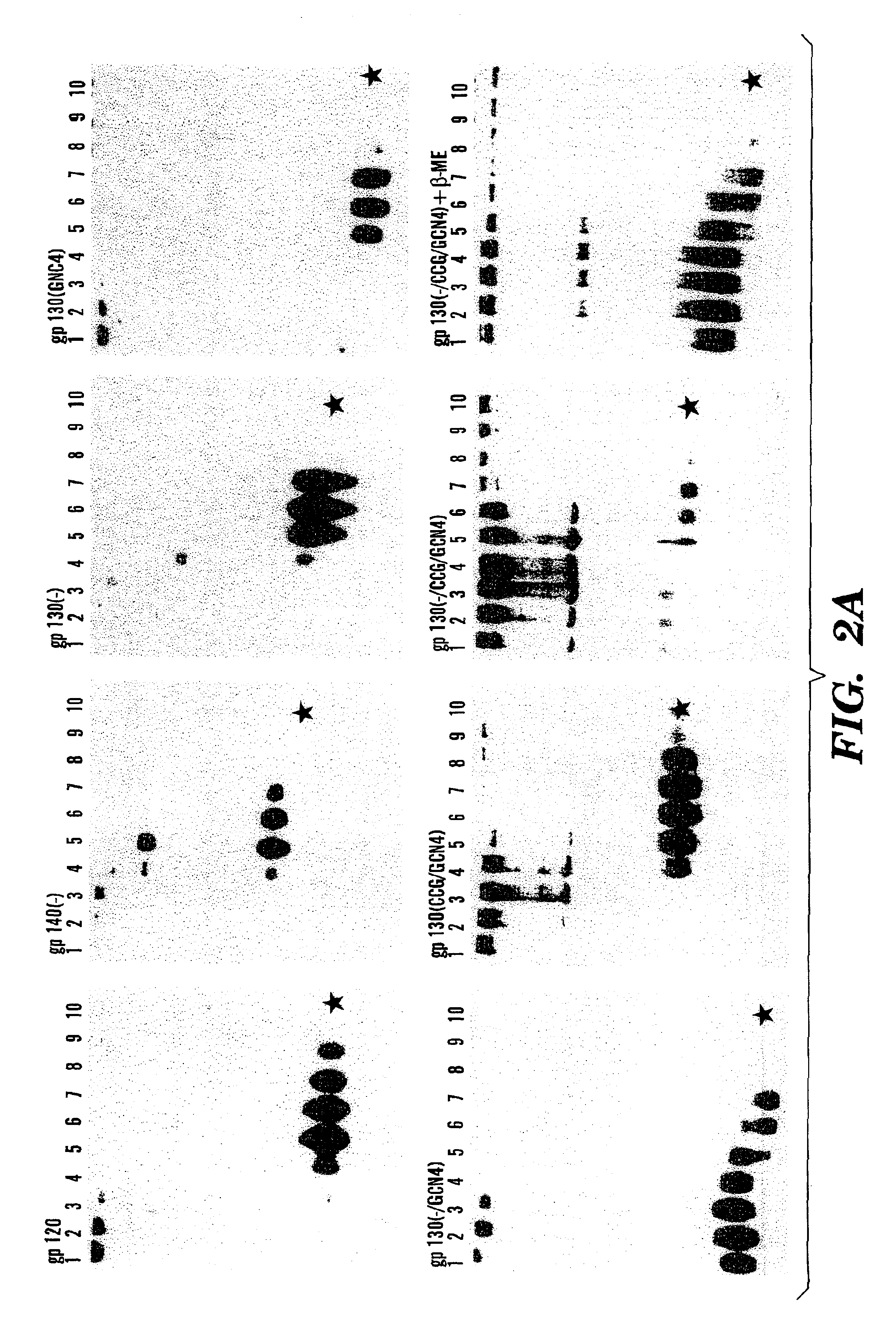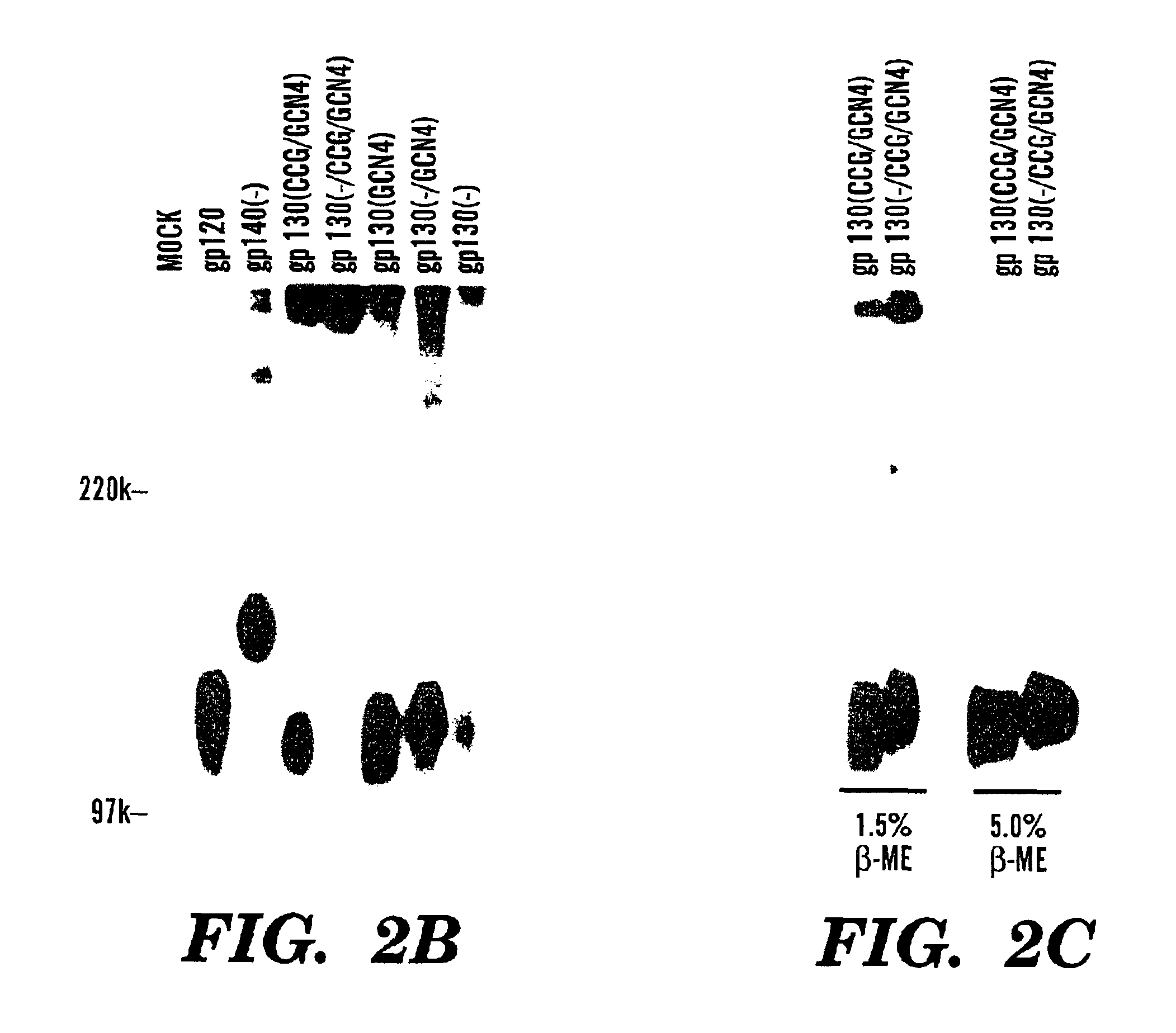Stabilized soluble glycoprotein trimers
a technology of soluble glycoproteins and trimers, which is applied in the direction of peptides, viruses, medical preparations, etc., can solve the problems that substitutions are not sufficient for stabilizing shortened soluble glycoproteins such as gp130 or gp140
- Summary
- Abstract
- Description
- Claims
- Application Information
AI Technical Summary
Benefits of technology
Problems solved by technology
Method used
Image
Examples
example 1
Stabilization of Soluble Glycoprotein Trimers by the GCN4 Coiled Coil Motif
Materials and Methods
[0102]Envelope Glycoprotein Constructs. The envelope glycoprotein expression plasmids were derived from pSVIIIenv and were constructed by polymerase chain reaction or by QuikChange (Stratagene) site-directed mutagenesis. The specific changes introduced into each mutant are described in the Results, infra. The sequence of the entire env open reading frame was determined for each of the mutants. Two differences between the wild-type YU2 gp120 glycoprotein and the soluble gp120 glycoprotein were noted. One of these apparently arose as a result of PCR error and converted the wild-type alanine 379 to glutamine. In addition, a single glycine residue was introduced at the C-terminus of the gp120 glycoprotein, after the arginine at position 508. All of the other glycoproteins used in the study exhibited the wild-type sequence of the YU2 R5 viral envelope glycoproteins, except where modifications ...
example 2
Stabilization of Variable-loop Deleted Soluble Trimers by the GCN4 Coiled-coil Motif
[0131]In one preferred method of immunization one would prime with a trimer having variable loop-deleted gp120, and then boost with a trimer that more closely approximates the wild type viral glycoprotein until at least one final boost with the stabilized wild type trimer. For example, if multiple variable regions and sugar addition sites are deleted from the priming trimer, the next boost will be with a trimer where more variable region amino acids are present and / or sugar addition sites present. Each boost will get closer to the wild type configuration until that configuration is reached.
[0132]FIG. 7 shows that variable loop-deleted HIV-1 proteins are still trimeric. These proteins are based upon gp140 (see FIG. 1) where the V1 and V2 variable loops have been deleted (−V1 / V2) and replaced with the sequence Gly-Gly-Gly. The GCN4 coiled coil is inserted at the carboxyl terminus. The resulting gp140-−...
example 3
Elicitation of Neutralizing Antibodies Against Primary HIV by Soluble Stabilized Envelope Glycoprotein Trimers
Materials and Methods
[0133]Plasmids. Details of the plasmids expressing soluble, stabilized trimers have been previously reported (Yang, X. et al., J. Virol. 74: 4746-4754, 1999; Yang, X. et al., J. Virol. 74: 5716-5725, 2000). Briefly, all plasmids were derivatives of the pSVIIIenv vector (Sullivan, et al., J. Virol. 69: 4413-4422, 1995). For production of soluble gp120 monomers, a stop codon was introduced into the env gene of the pSVIIIenv plasmid, resulting in termination after arginine 508 (amino acid residues are numbered according to the HXBc2 prototype). The gp120-gp41 proteolytic cleavage site was modified in the soluble, stabilized trimers by altering the arginines at residues 508 and 511 to serines. The GCN4 trimeric motif (MKQIEDKIEEILSKIYHIENEIARIKKLIGEV) (SEQ ID No:2) (Harbury et al., Science 262: 1401-7, 1993) was positioned after leucine 593 in the gp130(− / GC...
PUM
| Property | Measurement | Unit |
|---|---|---|
| final volume | aaaaa | aaaaa |
| temperature | aaaaa | aaaaa |
| volume | aaaaa | aaaaa |
Abstract
Description
Claims
Application Information
 Login to View More
Login to View More - R&D
- Intellectual Property
- Life Sciences
- Materials
- Tech Scout
- Unparalleled Data Quality
- Higher Quality Content
- 60% Fewer Hallucinations
Browse by: Latest US Patents, China's latest patents, Technical Efficacy Thesaurus, Application Domain, Technology Topic, Popular Technical Reports.
© 2025 PatSnap. All rights reserved.Legal|Privacy policy|Modern Slavery Act Transparency Statement|Sitemap|About US| Contact US: help@patsnap.com



